python 导入与初始化 BertTokenizer
from transformers import BertTokenizer
tokenizer = BertTokenizer.from_pretrained(pretrained_model_name_or_path='bert-base-chinese')
首先定义一些数据
sents = [
'选择珠江花园的原因就是方便。',
'笔记本的键盘确实爽。',
'房间太小。其他的都一般。',
'今天才知道这书还有第6卷,真有点郁闷.',
'机器背面似乎被撕了张什么标签,残胶还在。',
]
Tokenizer的几种使用方法(目前遇到的比较常用的、有新的后续补充)
附上hugging face 中,BertTokenizer 的说明文档
tokenizer.tokenize
只是将句子拆分为token,并不映射为对应的id
tokenizer.tokenize(sents[0])
############################################
['选', '择', '珠', '江', '花', '园', '的', '原', '因', '就', '是', '方', '便', '。']
tokenizer.convert_tokens_to_ids
将token映射为其对应的id
tokenizer.convert_tokens_to_ids(['选', '择', '珠', '江', '花', '园', '的', '原', '因', '就', '是', '方', '便', '。'])
############################################
[6848, 2885, 4403, 3736, 5709, 1736, 4638, 1333, 1728, 2218, 3221, 3175, 912, 511]
tokenizer.encode
这个函数只返回编码的结果(input_ids)
tokenizer.encode(sents[0])
############################################
[101, 6848, 2885, 4403, 3736, 5709, 1736, 4638, 1333, 1728, 2218, 3221, 3175, 912, 511, 102]
tokenizer.encode_plus
这种方法能够返回更多的编码信息,(更多编码信息后面说明)
tokenizer.encode_plus(sents[0])
#############################################
{
'input_ids': [101, 6848, 2885, 4403, 3736, 5709, 1736, 4638, 1333, 1728, 2218, 3221, 3175, 912, 511, 102],
'token_type_ids': [0, 0, 0, 0, 0, 0, 0, 0, 0, 0, 0, 0, 0, 0, 0, 0],
'attention_mask': [1, 1, 1, 1, 1, 1, 1, 1, 1, 1, 1, 1, 1, 1, 1, 1]
}
tokenizer.batch_encode_plus
以 batch 的形式去编码句子,返回的信息基本和 encode_plus 是一样的。
tokenizer.batch_encode_plus([sents[0], sents[1]])
###########################################################
{
'input_ids': [
[101, 6848, 2885, 4403, 3736, 5709, 1736, 4638, 1333, 1728, 2218, 3221, 3175, 912, 511, 102],
[101, 5011, 6381, 3315, 4638, 7241, 4669, 4802, 2141, 4272, 511, 102]
],
'token_type_ids': [[0, 0, 0, 0, 0, 0, 0, 0, 0, 0, 0, 0, 0, 0, 0, 0], [0, 0, 0, 0, 0, 0, 0, 0, 0, 0, 0, 0]],
'attention_mask': [[1, 1, 1, 1, 1, 1, 1, 1, 1, 1, 1, 1, 1, 1, 1, 1], [1, 1, 1, 1, 1, 1, 1, 1, 1, 1, 1, 1]]
}
编码过程中一些主要参数说明
多的不说 直接上例子文章来源:https://www.toymoban.com/news/detail-423510.html
out = tokenizer.encode_plus(
text=sents[0],
text_pair=sents[1],
#当句子长度大于max_length时,截断
truncation=True,
#一律补零到max_length长度
padding='max_length',
max_length=30,
add_special_tokens=True,
#可取值tf,pt,np,默认为返回list
return_tensors=None,
#返回token_type_ids
return_token_type_ids=True,
#返回attention_mask
return_attention_mask=True,
#返回special_tokens_mask 特殊符号标识
return_special_tokens_mask=True,
#返回offset_mapping 标识每个词的起止位置,这个参数只能BertTokenizerFast使用
#return_offsets_mapping=True,
#返回length 标识长度
return_length=True,
)
for k, v in out.items():
print(k, ':', v)
运行结果如下:文章来源地址https://www.toymoban.com/news/detail-423510.html
input_ids : [101, 6848, 2885, 4403, 3736, 5709, 1736, 4638, 1333, 1728, 2218, 3221, 3175, 912, 511, 102, 5011, 6381, 3315, 4638, 7241, 4669, 4802, 2141, 4272, 511, 102, 0, 0, 0]
token_type_ids : [0, 0, 0, 0, 0, 0, 0, 0, 0, 0, 0, 0, 0, 0, 0, 0, 1, 1, 1, 1, 1, 1, 1, 1, 1, 1, 1, 0, 0, 0]
special_tokens_mask : [1, 0, 0, 0, 0, 0, 0, 0, 0, 0, 0, 0, 0, 0, 0, 1, 0, 0, 0, 0, 0, 0, 0, 0, 0, 0, 1, 1, 1, 1]
attention_mask : [1, 1, 1, 1, 1, 1, 1, 1, 1, 1, 1, 1, 1, 1, 1, 1, 1, 1, 1, 1, 1, 1, 1, 1, 1, 1, 1, 0, 0, 0]
length : 30
到了这里,关于BertTokenizer 使用方法的文章就介绍完了。如果您还想了解更多内容,请在右上角搜索TOY模板网以前的文章或继续浏览下面的相关文章,希望大家以后多多支持TOY模板网!










